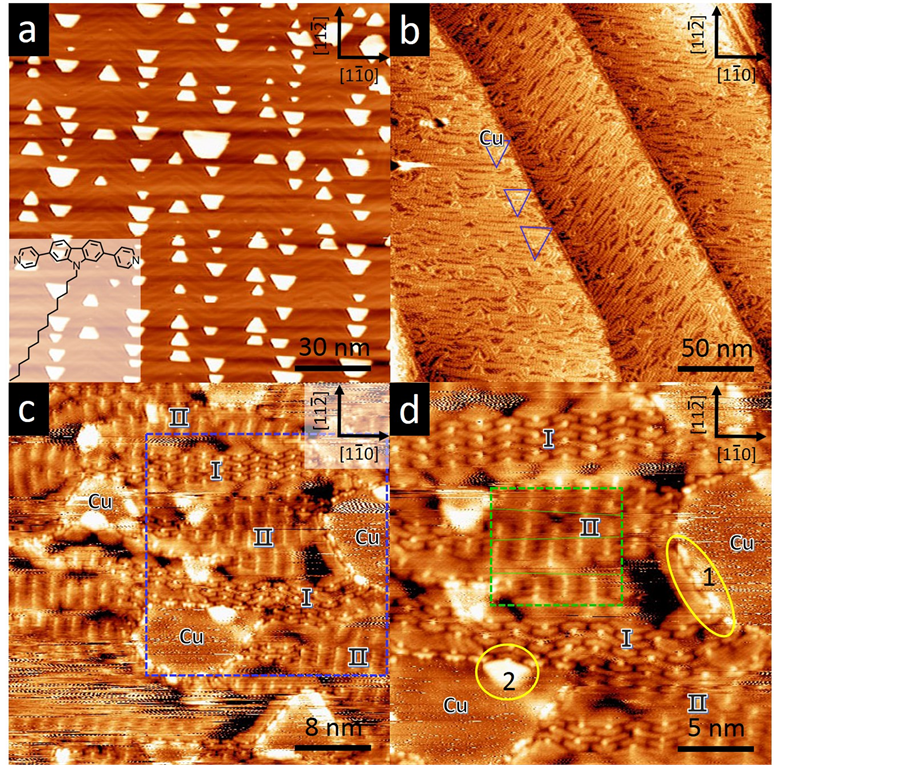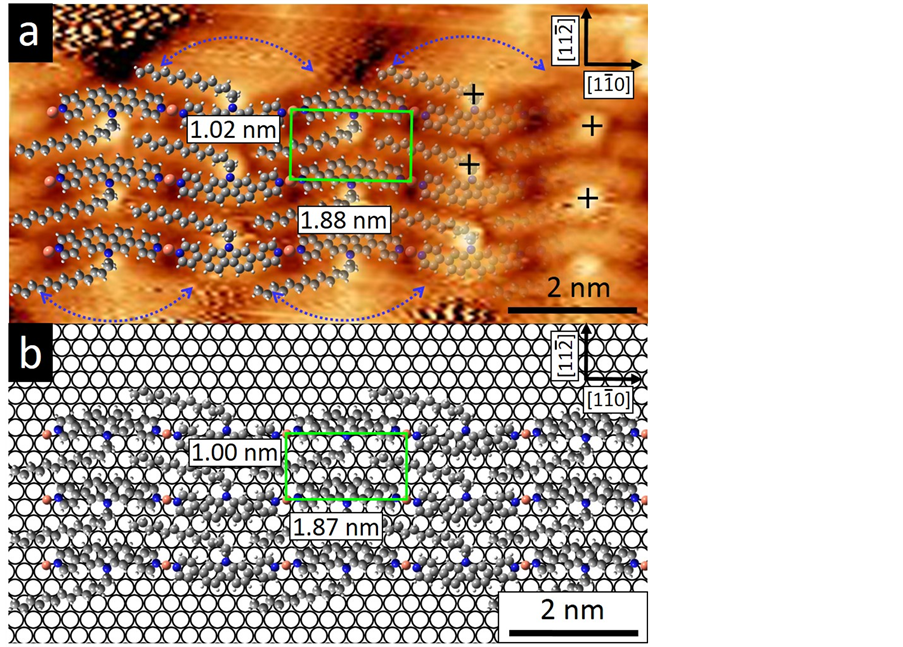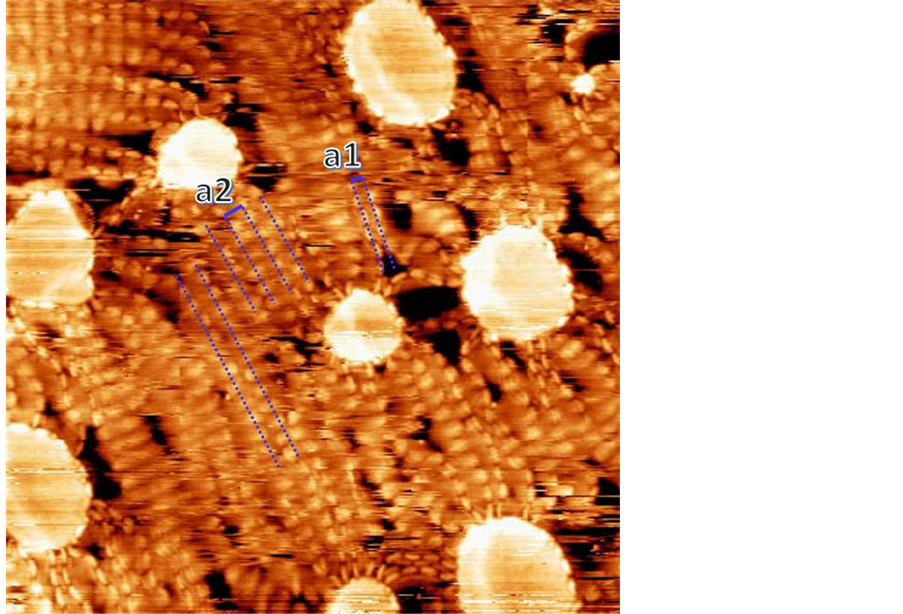Applied Physics
Vol.07 No.06(2017), Article ID:21071,8
pages
10.12677/APP.2017.76023
Tuning the Supramolecular Coordination Self-Assembly on Au(111) Surface by Molecular Flexible Side Chains
Yang Song, Yuxu Wang, Kun Zhou
Center for Soft Condensed Matter Physics & Interdisciplinary Research, Soochow University, Suzhou Jiangsu

Received: Jun. 1st, 2017; accepted: Jun. 19th, 2017; published: Jun. 22nd, 2017

ABSTRACT
In this paper, we studied the effect of molecular flexible side chains on the supramolecular coordination self-assembly on metal surface, by using an ultra-high vacuum-scanning tunneling microscope (UHV-STM). The organic molecule L is composed of a carbazole skeleton with two pyridyl group and a tetradecyl side chain. On the Au (111) surface with predeposited Cu atoms, the molecules L coordinate with Cu via the pyridyl terminals into chains, while. STM study shows that the tetradecyl side chain of the molecule L oscillates on the surface due to its thermal energy at room temperature. Analysis based on high-resolution images reveals that the steric hindrance caused by the side chain oscillation regulates the arrangement of the assembled metal-organic coordination chains. This experiment is of great significance for understanding and using the flexible side chains in the surface self-assembly structure.
Keywords:Scanning Tunneling Microscope, Supramolecular Self-Assembly, Metal-Organic Coordination, Steric Hindrance
分子柔性侧链对Au(111)表面超分子配位自组装的调控
宋洋,王余旭,周坤
苏州大学,软凝聚态物理及交叉研究中心,江苏 苏州
收稿日期:2017年6月1日;录用日期:2017年6月19日;发布日期:2017年6月22日

摘 要
在本文中,我们借助超高真空–扫描隧道显微镜(UHV-STM),研究了分子柔性侧链(flexible side chain)对金属表面超分子配位自组装的调控作用。有机分子L由带吡啶基(pyridyl(py))的咔唑骨架和一条十四烷基侧链构成。在预先沉积了Cu的Au(111)表面上,分子L可以通过py-Cu-py配位方式连接成链。STM研究显示,室温下有机分子L的十四烷基链由于自身热能而在衬底表面高速摆动。实验发现这种由侧链的摆动引起的空间位阻(steric hindrance)效应能够调控金属有机配位分子链的间距。本实验对于理解和利用柔性侧链在表面自组装结构中的调控作用具有重要的意义。
关键词 :扫描隧道显微镜,超分子自组装,金属有机分子配位,位阻

Copyright © 2017 by authors and Hans Publishers Inc.
This work is licensed under the Creative Commons Attribution International License (CC BY).
http://creativecommons.org/licenses/by/4.0/


1. 绪论
如今纳米科技在很多领域得到广泛研究和应用,如数据存储 [1] 、药物开发 [2] [3] 、水的净化 [4] 等。超分子自组装在制备原子级精确的功能性纳米材料上独具优势 [5] 。超分子自组装是分子(或原子)间通过氢键、范德瓦尔斯作用、金属有机配位键等非共价键的连接方式,经过自我识别、自我修复组装成超分子结构的过程 [5] [6] [7] 。尽管金属表面受限的超分子自组装与三维(固相或液相)的超分子组装体系之间存在不同,但是研究二维受限的超分子自组装系统可以利用一系列现代表面探测技术,得到单原子单分子层次的关键信息,对理解三维超分子自组装的相关机制有重要意义。同时,二维受限的超分子自组装比三维多了一个重要的互作用——分子与衬底间的作用力,因而呈现出很多与空间受限相关的新的物理化学特性,代表了一类新型的低维材料。金属有机配位键是一种键能较强(0.2~2 eV) [8] 的非共价键,因此其自组装结构比较稳定。近十多年利用金属有机配位键进行表面自组装的研究有很多 [8] ,如S. L. Tait等人利用py–Cu二重配位方式在 Cu(110)衬底上构筑一维分子链 [9] ,D. Kühne等人利用-CN-Co二重配位方式在 Ag(111)衬底上构筑了二维蜂窝状结构 [10] ,J. I. Urgel等人利用-COO-Gd四重配位方式在Cu(111)衬底上构筑了方形网络结构 [11] 。基于科研者大量出色的配位自组装研究工作,已经总结出一些配位规则 [8] 。我们可以利用这些配位规则,通过改变配位金属和配位分子来调控配位自组装结构。除此之外还有很多常用的调控自组装结构的方法,如使用不同衬底 [12] 、加入guest分子 [13] 、改变分子覆盖率 [14] 等。
在本文中,我们借助超高真空–扫描隧道显微镜(UHV-STM),研究了分子柔性侧链 [15] 对金属表面超分子配位自组装的调控作用。有机分子L(2,7-di(pyridin-4-yl)-9-tetradecyl-9H-carbazole)由带吡啶基团(-py)的咔唑骨架和一条十四烷基侧链构成(见图1(a)插图)。在预先沉积了Cu的Au(111)表面上,分子L可以通过py-Cu-py配位方式连接成链。STM研究显示,室温下有机分子L的十四烷基链由于自身热能在衬底表面高速摆动。实验发现这种由侧链的摆动引起的空间位阻(steric hindrance [15] )效应能够调控金属有机配位分子链的间距。

Figure 1. STM diagram of self-assembly of flexible molecule L and Cu on Au (111). (a) Cu islands on Au (111). The image at lower left corner shows the molecular structure formula of molecule L. (b) Molecule L and Cu atoms are self-assembled into a chain structure. (c), (d) high resolution STM diagram: the letter “Cu” represents the Cu islands on the surface of Au (111), and the letter “I” represents molecular chains in the stationary state, and the letter “II” represents molecular chainsin the moving state. Tunneling parameters: (a) U = 0.8 V, I = 200 pA; (b) U = −1 V, I = 50 pA; (c) U = −1 V, I = 50 pA; (d) U = −1 V, I = 50 pA
图1. 柔性分子L与Cu在Au(111)上配位自组装的STM图。(a) Cu岛在Au(111)表面,左插图为分子L结构式;(b) L分子与Cu原子自组装为链状结构。(c) (d) 高分辨率的STM图:字母“Cu”表示Au(111)表面的Cu岛,字母“I”表示静止状态的分子链,字母“II”表示运动状态的分子链。STM扫描条件:(a) U = 0.8 V,I = 200 pA;(b) U = −1 V,I = 50 pA;(c) U = −1 V,I = 50 pA;(d) U = −1 V,I = 50 pA
2. 实验方法
实验均在超高真空扫描隧道显微镜(UHV-STM, Aarhus 150, Specs GmbH)系统中进行。UHV-STM系统工作气压在3 × 10−10 mbar左右。干净的单晶金属衬底Au(111)是经过多次Ar+束轰击衬底表面和对衬底退火处理(800 K, 15 min)得到的。样品冷却到室温后,利用有机分子束蒸发源把有机分子L以气态形式蒸发到衬底表面。参与配位的Cu原子利用电子束蒸发源蒸发到衬底表面。衬底表面上的分子和原子在非共价相互作用力的驱动下自组装为一定的结构。所有的STM图都是在室温(~20℃)时STM工作在恒流模式下得到的。
3. 实验结果与讨论
3.1. 分子L与Cu原子在Au(111)表面配位自组装
在处理干净的Au(111)表面沉积Cu原子,可以看到Cu原子在Herringbone的弯角处聚集成岛,如图1(a)。同时,herringbone结构是与Au(111)表面的晶向相关的,我们因此确定了Au(111)表面的晶格方向(见图1(a)右上角)。在图1(a)所示的样品上蒸发沉积L分子,实验结果如图1(b)。大范围内我们可以看到大量一维链状结构以近似相互平行的方式覆盖在Au(111)表面。由于py-Cu的配位作用 [16] [17] ,我们推断这些链状结构是分子L与Cu原子通过“Cu-py-Cu”连接而成的分子链。在该样品中,Cu的覆盖率较高,除用于与分子配位的铜外(STM图未显示),表面上存在多余的Cu岛(图1(b)中用蓝色线框标出部分Cu岛)。可以看到大部分链状结构是从Cu岛边缘延伸生长并有一定取向。通过仔细观察发现“Cu-L”分子链在衬底上只有三个方向,这三个方向与衬底的三个<1 0>晶向一致。从自组装结构的方向与衬底晶向的高度一致可以判断分子与衬底间的吸附作用对自组装结构起到了重要作用 [18] 。
0>晶向一致。从自组装结构的方向与衬底晶向的高度一致可以判断分子与衬底间的吸附作用对自组装结构起到了重要作用 [18] 。
进一步地,我们在小区域的STM图1(c)中发现,分子链有两种组合状态。在图1(c),图1(d)中,字母“Cu”表示Au(111)表面的Cu岛,字母“Ⅰ”表示一维分子链的静止状态,字母“Ⅱ”表示一维分子链的运动状态,右上角标出衬底晶向。从STM图上看到处于Ⅱ状态的一维分子链模糊不清,这是STM扫描速度相对于高速运动的分子比较迟缓造成的。这样随着STM扫描的进行,得到的图像可以呈现同一分子不同时刻的多个像。即扫描一个点可能变成多个点,甚至可能变成一条线,如图1(d)中绿色点线框标出的区域中的亮线实际是振动的亮点。实际上整个绿色区域内只有4条分子链,已用绿色直线大体分开。大多数的分子链处于不稳定的Ⅱ态,少数的分子链处于稳定的Ⅰ态。在大尺寸的图中看不清楚分子的细节,但是可以从分子链的形貌来判断是Ⅰ态还是Ⅱ态,例如图1(b)中大多数分子链间有一定的间隙,不是宽而清晰的Ⅰ态,我们可以判定多数区域是运动的Ⅱ态。分子链处于运动状态的原因是分子的动能大于衬底表面阻碍分子运动的势垒的能量,这样分子链就可以跃过势垒在衬底上运动 [6] 。所以在一些研究中增大自组装分子的动能可以使静止的分子变成运动的分子,例如在自组装实验中通常采取退火的手段得到稳态结构也是根据这个原理 [17] [19] [20] 。Cu岛边缘比分子亮一些,这是因为与Cu岛相连接的L分子的一部分(咔唑端或烷基链)在Cu岛上面(图1(c),图1(d))。咔唑端如图1(d)中黄圈1所示,烷基链如图1(d)中黄圈2所示。
如前文所述,从自组装结构的方向与衬底高对称性晶向的一致性可以推断分子与衬底间的作用力对自组装结构起到了重要作用 [18] 。我们首先从静止的分子链——Ⅰ态出发,分析分子链与衬底的关系。如图2(a)、图2(b)分别是相同尺寸的严格校准后的STM图和相对应的模型图。由图2(a)的STM图测得分子链的周期(Cu-L-Cu)为1.88 nm,分子链的间距(Cu-Cu)为1.02 nm。模型中(图2(b))把配位的Cu原子都置于衬底的bridge位,这样摆模型的好处是所有分子都位于相同的衬底吸附位置,而且既符合STM测量值又与衬底有较好周期性的模型结构仅此一个。图2(b)的模型图可通过衬底的晶格常数——2.88 Å计算得分子链的周期(Cu-L-Cu)为1.87 nm,分子链的间距(Cu-Cu),也是垂直于分子链方向上的周期,为1.00 nm。可见模型值与测量值吻合,即模型是合理的。图2(b)中用圆圈代表Au(111)衬底的第一层原子,最近邻圆心距表示单晶Au的最近邻原子距2.88 Å,对应尺寸的分子模型摆到衬底上。这里分子模型中侧链位置的确定是综合考虑了三个方面的因素得出的:1) 侧链离两边H原子不能太近;2) 侧链在STM图的实际位置、3) 侧链只能绕C-C单键转动。在图2(b)提出的模型中给出的所有L分子在衬底的吸附位置都相同,同一分子链中相邻分子虽然方向相反,但是在衬底的吸附位置也是相同的。这样的全同吸附反映的是衬底对分子的限制作用。根据以上,我们验证了推测:分子(配位原子)与衬底的相互作用决定了分子链方向。

Figure 2. An STM image and a model image of state I. (a) The molecular model image of state I is on the STM image. Molecules coordinate by Py-Cu-Py style. The green rectangle indicates that the cycle of molecular chain is 1.88nm, and the distance between molecular chains is 1.02 nm. (b) Model image of state I and Au (111) substrate. The green rectangle indicates that the cycle of molecular chain is 1.87 nm, and the distance between molecular chains is 1.00 nm. Tunneling parameters: (a) U = −1 V, I = 50 pA
图2. I态的STM图以及模型图。(a) 分子模型放到I态的STM图上。分子配位方式为Py-Cu-Py,绿色长方形框指示了分子链的周期为1.88 nm、分子链间距为1.02 nm。(b) I态与Au(111)衬底的模型图。绿色长方形框表示了分子链的周期为1.87 nm、分子链间距为1.00 nm,右上角标出衬底晶向。STM扫描条件:(a) U = −1 V,I = 50 pA
图2(a)中可以观察到分子L上有一个明显的亮点,位于靠近咔唑的位置,如图2(a)四个黑色十字标记处。通过对应的分子模型知不是N原子的位置,而是在第二个C原子的位置。N. Hauptmann等人的一项工作中对这种现象给出了详细的说明 [21] 。他们认为这是由于分子沉积到衬底上后第二个C原子和相邻苯环上的H原子的位阻排斥作用使C原子离开衬底表面向上。分子为了重新回到衬底表面与衬底有相互作用,第三个C原子与第二个C原子采取gauche构型而高于周围原子。通过等比例的模型图与STM图的对比知第二个C原子与第三个C原子位置对应于STM图亮点处,如图2(a)。
如上所述,L分子与Cu原子自组装成金属有机配位分子链,大多数的分子链处于Ⅱ态,少数的分子链处于Ⅰ态。下面我们来具体讨论Ⅱ态的结构,发现分子链的状态与分子L的侧链的状态相关。Ⅰ态分子岛边缘的侧链在衬底上高频率地摆动成扇形区域(如图2(a)中蓝色点弧线),Ⅱ态中侧链都处于这种摆动状态。图1中明确表示了Ⅱ态的分子链在衬底表面振动。因此,L分子侧链的摆动加上分子链整体的振动就是Ⅱ态的结构特点。图3中,虽然分子形状模糊不清,但是大多数分子的位置能分辨出来。仔细观

Figure 3. STM image of state II. The bright approximate circular regions are Cu islands, and the rest regions are the molecular chains in state II. The size of STM image is 60 nm × 60 nm. Tunneling parameters: U = −1 V, I = 50 pA
图3. II态的STM图。亮的近似圆形区域是Cu岛,其余部分是II态的分子链。图尺寸:60 nm × 60 nm。STM扫描条件:U = 1.4 V,I = 50 pA
察发现Ⅱ态比Ⅰ态的分子链间距大得多(这里是把咔唑的位置看作分子链的位置)。图3中蓝色虚线粗略表示分子链的位置,Ⅰ态的分子链间距a1为1.02 nm (图2(a)),Ⅱ态的分子链间距a2约为2.0~3.0 nm,可见a2比a1大许多。从图3 中可以看出Ⅱ态中分子链之间填满了高速摆动的分子侧链,所以侧链的存在对分子链间距起到了调控作用。这里侧链对结构的影响类似于H. Cun等人利用侧链引起的位阻对自组装结构进行调控 [15] 。H. Cun的研究利用了增大分子覆盖率,从而产生位阻(steric hindrance),迫使侧链上摆。不同的是本实验中侧链的摆动是由分子侧链在室温下具有一定的热能导致的,不需要增大分子覆盖率来制造位阻。
3. 结论
本文利用柔性分子L与Cu原子在Au(111)表面通过Py-Cu-Py配位键实现了金属有机分子链自组装。分子链在衬底上有两种状态:一个是静止于衬底表面的Ⅰ态,另一个是在表面摆动的Ⅱ态。Ⅰ态中L分子或Cu原子在衬底上有特定的吸附位,从而使分子链的三个方向与Au(111)衬底上的三个<110>晶向一致。经过测量发现Ⅱ态比Ⅰ态的分子链间距大得多,这是因为Ⅱ态中分子链之间填满了高速摆动的侧链,这些侧链利用摆动产生的位阻把分子链隔开。实验发现这种由侧链的摆动引起的空间位阻效应能够调控金属有机配位分子链的间距。所以侧链的存在对分子链间距起到了调控作用,这种利用侧链调控结构的方法也可以用到其他长链有机分子的自组装中。这种利用分子侧链对自组装结构的调控作用需要在其他类型的自组装结构中,如二维多孔的网络结构中,进行更加深入和广泛的研究。
文章引用
宋 洋,王余旭,周 坤. 分子柔性侧链对Au(111)表面超分子配位自组装的调控
Tuning the Supramolecular Coordination Self-Assembly on Au(111) Surface by Molecular Flexible Side Chains[J]. 应用物理, 2017, 07(06): 165-172. http://dx.doi.org/10.12677/APP.2017.76023
参考文献 (References)
- 1. Menon, A.K. and Gupta, B.K. (1999) Nanotechnology: A Data Storage Perspective. Nanostructured Materials, 11, 965-986.
- 2. Farokhzad, O.C. and Langer, R. (2009) Impact of Nanotechnology on Drug Delivery. ACS Nano, 3, 16-20. https://doi.org/10.1021/nn900002m
- 3. Shi, J., Votruba, A.R., Farokhzad, O.C. and Langer, R. (2010) Nanotechnology in Drug Delivery and Tissue Engineering: From Discovery to Applications. Nano Letters, 10, 3223-3230. https://doi.org/10.1021/nl102184c
- 4. Shannon, M.A., Bohn, P.W., Elimelech, M., Georgiadis, J.G., Marinas, B.J. and Mayes, A.M. (2008) Science and Technology for Water Purification in the Coming Decades. Nature, 452, 301-310. https://doi.org/10.1038/nature06599
- 5. Lehn, J.M. (1993) Supramolecular Chemistry. Science, 260, 1762-1763.
- 6. Kühnle, A. (2009) Self-Assembly of Organic Molecules at Metal Surfaces. Current Opinion in Colloid & Interface Science, 14, 157-168.
- 7. Yang, Y. and Wang, C. (2009) Solvent Effects on Two-Dimensional Molecular Self-Assemblies Investigated by Using Scanning Tunneling Microscopy. Current Opinion in Colloid & Interface Science, 14, 135-147.
- 8. Dong, L., Gao, Z.A. and Lin, N. (2016) Self-Assembly of Metal-Organic Coordination Structures on Surfaces. Progress in Surface Science, 91, 101-135.
- 9. Tait, S.L., Langner, A., Lin, N., Stepanow, S., Rajadurai, C., Ruben, M. and Kern, K. (2007) One-Dimensional Self- Assembled Molecular Chains on Cu(100): Interplay between Surface-Assisted Coordination Chemistry and Substrate Commensurability. The Journal of Physical Chemistry C, 111, 10982-10987. https://doi.org/10.1021/jp071100v
- 10. Kühne, D., Klappenberger, F., Decker, R., Schlickum, U., Brune, H., Klyatskaya, S., Ruben, M. and Barth, J.V. (2009) High-Quality 2D Metal-Organic Coordination Network Providing Giant Cavities within Mesoscale Domains. Journal of the American Chemical Society, 131, 3881-3883. https://doi.org/10.1021/ja809946z
- 11. Urgel, J.I., Cirera, B., Wang, Y., Auwärter, W., Otero, R., Gallego, J.M., Alcamí, M., Klyatskaya, S., Ruben, M., Martín, F., Miranda, R., Ecija, D. and Barth, J.V. (2015) Surface-Supported Robust 2D Lan-thanide-Carboxylate Coordination Networks. Small, 11, 6358-6364. https://doi.org/10.1002/smll.201502761
- 12. Sirtl, T., Schlögl, S., Rastgoo-Lahrood, A., Jelic, J., Neogi, S., Schmittel, M., Heckl, W.M., Reuter, K. and Lackinger, M. (2013) Control of Intermolecular Bonds by Deposition Rates at Room Temperature: Hydrogen Bonds versus Metal Coordination in Trinitrile Monolayers. Journal of the American Chemical Society, 135, 691-695. https://doi.org/10.1021/ja306834a
- 13. Sun, J., Yu, Y., Liu, C. and Lei, S. (2017) Surface- and Guest-Promoted Product Selection from a Dynamic Covalent Library: A Scanning Tunneling Microscopic Study. The Journal of Physical Chemistry C, 121, 3437-3444. https://doi.org/10.1021/acs.jpcc.6b12180
- 14. Shen, Y., Tian, G., Huang, H., He, Y., Xie, Q., Song, F., Lu, Y., Wang, P. and Gao, Y. (2017) Chiral Self-Assembly of Nonplanar 10,10’-Dibromo-9,9’-Bianthryl Molecules on Ag(111). Langmuir, 33, 2993-2999. https://doi.org/10.1021/acs.langmuir.7b00218
- 15. Cun, H., Wang, Y., Du, S., Zhang, L., Zhang, L., Yang, B., He, X., Wang, Y., Zhu, X., Yuan, Q., Zhao, Y.-P., Ouyang, M., Hofer, W.A., Pennycook, S.J. and Gao, H.-J. (2012) Tuning Structural and Mechanical Properties of Two-Dimen- sional Molecular Crystals: The Roles of Carbon Side Chains. Nano Letters, 12, 1229-1234. https://doi.org/10.1021/nl203591t
- 16. Adisoejoso, J., Li, Y., Liu, J., Liu, P.N. and Lin, N. (2012) Two-Dimensional Metal-lo-Supra molecular Polymerization: Toward Size-Controlled Multi-Strand Polymers. Journal of the American Chemical Society, 134, 18526-18529. https://doi.org/10.1021/ja308480x
- 17. Shi, Z., Liu, J., Lin, T., Xia, F., Liu, P.N. and Lin, N. (2011) Thermodynamics and Selectivity of Two-Dimensional Metallo-Supramolecular Self-Assembly Resolved at Molecular Scale. Journal of the American Chemical Society, 133, 6150-6153. https://doi.org/10.1021/ja2010434
- 18. Fan, Q., Wang, C., Han, Y., Zhu, J., Kuttner, J., Hilt, G. and Gottfried, J.M. (2014) Surface-Assisted Formation, Assembly, and Dynamics of Planar Organometallic Macrocycles and Zigzag Shaped Polymer Chains with C-Cu-C Bonds. ACS Nano, 8, 709-718. https://doi.org/10.1021/nn405370s
- 19. Han, P., Akagi, K., Federici Canova, F., Shimizu, R., Oguchi, H., Shiraki, S., Weiss, P.S., Asao, N. and Hitosugi, T. (2015) Self-Assembly Strategy for Fabricating Connected Graphene Nanoribbons. ACS Nano, 9, 12035-12044. https://doi.org/10.1021/acsnano.5b04879
- 20. Kong, X.-H., Deng, K., Yang, Y.-L., Zeng, Q.-D. and Wang, C. (2007) Effect of Thermal Annealing on Hydrogen Bond Configurations of Host Lattice Revealed in VOPc/TCDB Host-Guest Architectures. The Journal of Physical Chemistry C, 111, 9235-9239. https://doi.org/10.1021/jp070328f
- 21. Hauptmann, N., Scheil, K., Gopakumar, T.G., Otte, F.L., Schütt, C., Herges, R. and Berndt, R. (2013) Surface Control of Alkyl Chain Conformations and 2D Chiral Amplification. Journal of the American Chemical Society, 135, 8814- 8817. https://doi.org/10.1021/ja4036187